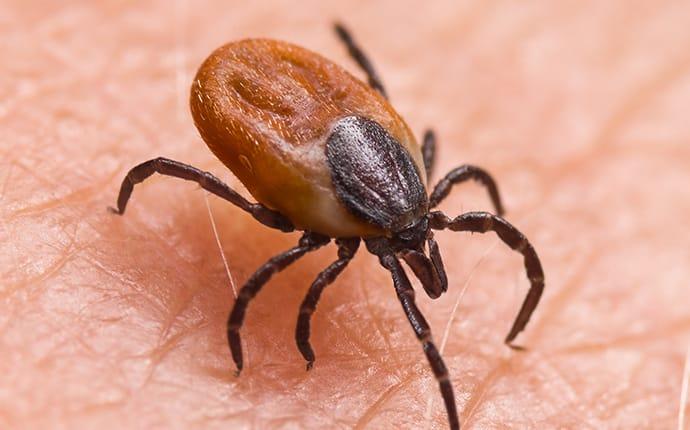Ticks are small blood-sucking bugs that attach themselves to a host and feed until they’re full. There are four species in particular that are most common in the Greater Houston area.
Lone Star Tick
These ticks live in wooded areas with thick underbrush and high grass. They’re aggressive feeders that travel long distances to pursue their hosts and can be characterized by the white star-shaped dot in the center of their backs.
American Dog Tick
These ticks often feed on domestic dogs and are known for carrying disease-spreading bacteria. They’re found in grassy fields with little tree coverage and are brown in color with whitish-gray markings.
Brown Dog Tick
These reddish, brown creatures become gray when engorged and are commonly found in homes, animal pens, and dog kennels. They prefer warm, dry conditions and do not need to travel far as they can complete their full life cycle indoors. They usually attach themselves to their host’s ears or between their toes.
Deer Tick
These ticks have reddish bodies with black markings. They’re mostly found in grass, shrubs, and deciduous forest areas, as their favorite host is the white-tailed deer. They’re smaller in size than the common dog tick.
Ticks are the leading carriers of Lyme disease but they can also carry several other blood-borne diseases than can have severe effects on your health.
Rocky Mountain Spotted Fever
This is an infectious bacterial disease that can become deadly if not treated in a timely manner with the correct antibiotics. It starts with a distinctive rash on the wrist and ankles and progresses to fever, vomiting, abdominal pain, and muscle aches.
Babesiosis
This is another blood infection spread by ticks. They carry microscopic parasites that infect red blood cells and cause malaria-like symptoms.
Tularemia
This is a rare infectious disease that is highly contagious. It attacks the skin, eyes, lymph nodes, and lungs and can be potentially fatal if not treated promptly with antibiotics.
Ehrlichiosis
This is a bacterial illness that causes flu-like symptoms, this disease weakens the immune system and puts you at risk for kidney failure, heart failure, respiratory failure, seizures, and coma. It is closely related to Anaplasmosis and is known to be transmitted primarily through the Lone Star Tick.
How To Remove A Tick
If you see a tick on you, your loved one, or your pet, remove it immediately to prevent diseases from spreading. Using clean tweezers and rubber gloves, steadily grasp the entire body of the tick and pull it out carefully. Do not let the body break in half as the fluids can cause infection and it may leave its head stuck into your skin. Once the tick is removed, dispose of it immediately.
Houston Tick-Prevention Tips
1. If you’re visiting a high-tick area, make sure to wear protective clothing such as long pants tucked into your socks. Avoid tick habitats like densely wooded areas with high grass.
2. Wear tick repellents with DEET or permethrin. Protect your pets from infestation with topical ointments, oral medications, or repellant collars.
3. Create a tick-resistant perimeter around your home. Regularly mow your grass, remove piles of wood, and maintain proper disposal of leaves, trimmings, and trash. Also, remove food and water sources. This will discourage wildlife from visiting and thus bringing ticks onto your property.
4. Make a fenced-in play area for your pets so that wildlife and rodents cannot get into it and your pets cannot get out. This will reduce the chances of your pets picking up ticks.
5. Invest in pest control services from Romney Pest Control.
The safest way to protect your yard and your home from a tick infestation is to rely on the expertise of the dedicated team at Romney Pest Control. Our licensed professionals and seasoned pest control specialists are experienced at identifying ticks, treating your property to eliminate them, and suggesting strategies to prevent their returning. Call us today for a free quote.




